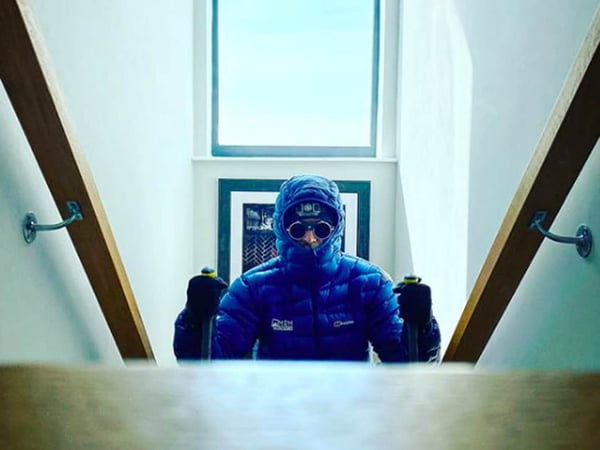
Daily Mountain
48 years, Australia
Ed Jackson: The quadriplegic climber scaling Everest in his parents’ house
This article first appeared on http://www.independent.co.uk. The original can be read here.
After an accident left him paralysed from the shoulders down, the ex-rugby player recalls his remarkable recovery and tells Lawrence Ostlere he hopes to inspire others facing adversity with his latest challenge.
 Ed Jackson begins his ascent of the staircase ( Ed Jackson/Instagram )
Ed Jackson begins his ascent of the staircase ( Ed Jackson/Instagram )
The most extraordinary thing about Ed Jackson isn’t that he climbed a mountain a year after hitting his head on the bottom of a swimming pool, breaking his neck and leaving him paralysed from the shoulders down; nor that he is now climbing the height of Mount Everest in his parents’ house three years after being told he would never walk again. It’s that despite one stroke of misfortune ending his rugby career and taking away most of his mobility from the waist down, he is so infectiously upbeat about life that somehow he impels you, slovenly sofa-bound, to charge up a mountain with him.
“Weirdly, I quite enjoy this sort of stuff,” Jackson says of the pain his new challenge brings. He is a little out of breath, speaking during a short break on day one of his mission to climb his parents’ staircase a quite ridiculous 2,783 times, mimicking Everest’s height of 8,848m. It has raised £23,550 and counting for both the hospital in Bath which helped get him back on his feet and Wings for Life, a spinal cord research foundation which like so many charities has seen fundraising opportunities wiped out by coronavirus. He has blisters on his hands from holding the handrails, his left leg is a constant drag and he is fairly certain he’s going to climb his way into more physical problems as the challenge goes on, but the 31-year-old is just happy to be alive.
“There’s something about the mental challenge that I like, the monotony… But you’re asking me on day one at lunchtime, so we’ll see.”
Jackson might not be here had it not been for the quick reactions of his dad, a retired GP, who was in the pool when the accident happened on 8 April 2017. Unable to move in the water, Jackson’s dad held up his son’s body while a woman he barely knew, who would later become a good friend, held his head so he could breathe. The decision to cut through the skin on a major swelling on his neck where a disc had shattered probably saved his life.
“I had to be resuscitated three times, so I got pretty lucky that I’m here at all, never mind hobbling around. I didn’t have any movement or sensations for about a week, so obviously we feared the worst. The doctors were telling me there was very little if no chance I would ever walk again, but that hopefully I would get the use of my arms back.”
At the end of a terrifying first week, a toe twitched into life. “Bit by bit, things started coming back. After nine months I was out of the wheelchair. I’m still very much disabled: I’m technically a walking quadriplegic, if you like. I have Brown-Sequard Syndrome. My left side doesn’t function very well physically; my right side does but I’ve got not no sensation. So I’m doing this challenge pretty much all on my right leg, which makes it a bit more tricky.”
It was during a recovery built on spades of willpower and determination to urge his body to move, inches at a time, that Jackson began to get a thrill from inspiring others.
In hospital he met a man named Nasser who had long given up hope of ever leaving his wheelchair. Jackson encouraged him to go to the gym and push himself, and six months later Nasser messaged to say he was walking with a stick.
That feeling was part of what drove Jackson to set an extraordinary target, one his parents told him was utterly bonkers: to climb Snowdon, Wales’ highest mountain, on the one-year anniversary of his accident. Jackson wanted other quadriplegics to see him hauling himself to the top and to give them hope, something understandably in short supply.
“I wanted to set an example to all the other people in hospital with a negative diagnosis. They are told the lowest end of the scale because doctors don’t want to offer false hope, and also don’t want to open themselves up to litigation – that’s just the way the system works. Unfortunately that steals away hope from some people who might otherwise make a recovery. If we can just inspire a couple of people to keep trying then it’s worth it.”
He reached Snowdon’s summit on 1 April 2018. There he and his team celebrated – having not fallen once on the way up, Jackson had a couple of drinks and fell flat on his face, to great laughter.
It was up there he got the taste for mountaineering. “I climbed Snowdon and got completely addicted to it. The challenge of doing something physical and achieving something as a group took me back to my rugby days and what I’d been missing so much.”
Jackson soon got on with life. He got married, moved to France to set up a charitycalled M2M – a nod to his journey from millimetres to mountains – and completed his most gruelling challenge to date, leading a group ex-rugby players to the summit of Mount Buet in the Alps. Later, when climbing in Nepal, he felt compelled to do something about the inadequate treatment for spinal cord injuries there, helping to raise a quarter of a million pounds for a rehab unit.
After pushing himself through each new extreme, Jackson would see another change in his body. “Every time I’ve pushed myself neurologically, whether climbing a mountain or doing something like this, after my body’s recovered that’s when I see a new movement. Three years down the line after a spinal cord injury you’re not supposed to see much recovery, but I’m hoping that might happen next week.”
Anyone in his position would be forgiven for harbouring a little resentment about the hand life dealt. Jackson admits it has taken time to learn to “manage his negative thoughts”. Now he seems relentlessly cheerful and bullish about what he can achieve. He describes the lack of sensation in his right leg as “a blessing in disguise” because he can’t feel the pain he’s putting it through, and is indefatigable in the face of obstacles. “I’m pretty positive that even if physically I might not get to the top in the time I’ve set myself, mentally... well people have donated too much money for me not to.”
Each night for however long it takes, he is camping in a tent in his parents’ living room at the foot of the stairs. “They’re not that happy about it,” he says. “But they’re cheering me on. They think I’m an idiot, they always have doing stuff like this – I’ve never done anything quite as weird as this, but as a quadriplegic climbing mountains wobbling around on top of cliff edges, they think I’m stupid. They are used to me being ridiculous so at the moment they are playing ball. How long that lasts, we’ll see.”
Speaking 500 flights of stairs in, he hopes to complete them all by Friday night but knows his body might have other plans. Even so he is undeterred, and it is only strengthening his desire to conquer the real thing.
“I would be lying if I said I wasn’t interested in being the first quadriplegic to the top of Everest,” Jackson says. “I wouldn’t do it for my own self-esteem, it doesn’t interest me in that sense, but if it can inspire others then of course that’s the ultimate goal. Never say never. My mum hates it when I mention climbing Everest but unfortunately, if anything, climbing these stairs is going to make me want to do it even more.
“It’s ironic really, because walking up hills is functionally the most difficult thing for me to do. But I think that’s kind of the point.” And with that Jackson gets back to his task, walking past his tent to the foot of the stairs, looking up, his sights set as high as humanly possible.
Ed Jackson is a Wings for Life ambassador. To find out more about the spinal cord research foundation, visit www.wingsforlife.com





